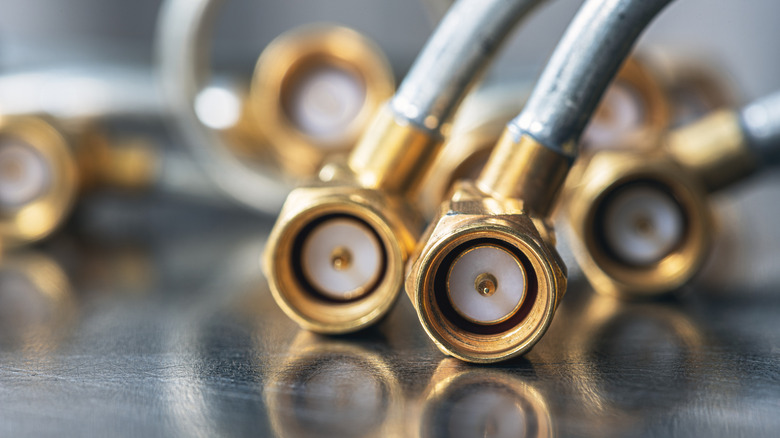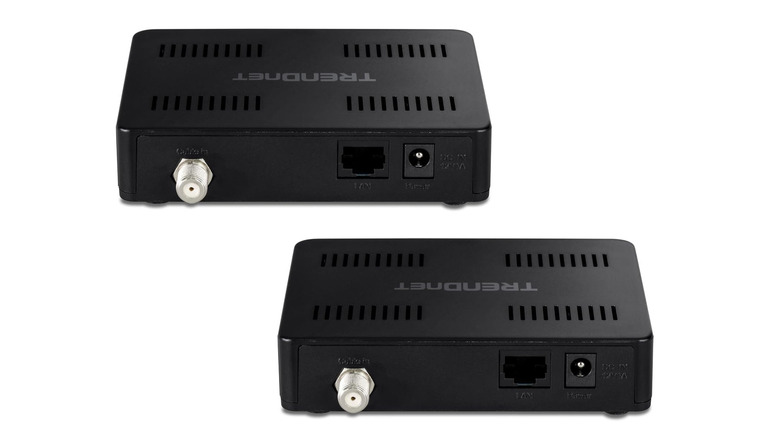Want Wired Internet, But Don't Want To Run Ethernet Cables? Here's The Alternative
We may receive a commission on purchases made from links.
Wi-Fi is undoubtedly convenient, without the need for wiring, it allows you to connect multiple devices to the internet with a minimum of fuss. However, there are downsides to wireless networks that can make them less than ideal. For instance, in larger homes or homes with "Wi-Fi unfriendly walls," the dreaded Wi-Fi blind spot can rear its ugly head. Even in instances where the signal is good, Wi-Fi is less reliable than a wired Ethernet connection. For example, for gamers, switching to an Ethernet connection can reduce lag without upgrading your internet connection.
One obvious solution to this is simply to switch to a wired connection. But unless you're fortunate enough to live in a house with existing Ethernet infrastructure, then this means having to run cables to everywhere that needs a connection. Not an ideal situation. Even for keen DIYers who own their home, this can be a time-consuming, messy, and costly solution. There is an alternative, though. Coax cables that are normally used to carry TV signals around the home can be repurposed to carry internet signals at speeds of up to 2.5 Gbps, similar to the way powerline adapters repurpose electrical wiring.
The technology allowing this repurposing of TV cables is called Multimedia over Coax Alliance (MoCA). MoCA normally works by using two adapters, one at the router end of the network and another where the wired connection is required. Let's have a closer look at how to ease your Wi-Fi woes with an existing cable network and some MoCA hardware.
How MoCA works and what hardware you'll need
Unless your existing internet router has an integrated MoCA port, you'll need at least two MoCA adapters to get started — one at the router end of the equation and another where the business end of the wired network is required. It's also possible to install multiple adapters throughout a household, with devices such as the TRENDnet MoCA 2.5 Adapter supporting up to 16 nodes. If you want to use this to boost Wi-Fi, you can use a MoCA Wi-Fi extender in place of a MoCA Ethernet adapter.
In most instances, the setup for MoCA adapters is minimal. All that is usually required is to plug the appropriate cables into the appropriate holes. At the router end, this involves running a coax cable from a cable outlet to the adapter and running an Ethernet cable from the MoCA port to a spare Ethernet port on your internet router. One proviso: if your internet service comes through a cable modem, you may need a coax splitter so that the line can feed both the modem and the MoCA adapter — fiber or DSL connections usually don't require this. One more recommendation is to install a POE filter to keep the signals contained within the coax network.
At the other end, simply connect another MoCA device to a coax outlet and link it to the device with an Ethernet cable. You now have a wired Ethernet network without having to lay new cables (picking the right Ethernet cable can also be important).
What are the disadvantages of MoCA?
The first thing to address is the cabling. If your home doesn't have an existing coax system where the coax outlets are internally connected, then this system won't work. Of course, you could run cables, but that defeats the point of the exercise.
There are also bandwidth restrictions to consider. While modern MoCA systems can connect up to 16 nodes, these all share the same bandwidth, i.e., at the router end, all these connections are fed through a single MoCA adapter. Not a consideration when connecting one or two devices, but certainly something that comes into play as you add more devices. (It's also possible to extend the number of connected devices by plugging the second adapter into a network switch and not directly into a device.)
Another consideration is expense; although setting up a MoCA system will undoubtedly be cheaper than a major rewiring exercise, the costs can still mount up. MoCA adapters will usually cost around $60 upwards, and for most people, two will be the minimum number to get started. It's also worth noting that the existing coax cabling network structure and the quality of the cabling and components can affect the quality. For instance, MoCA signals use frequencies that are much higher than traditional cable TV, so older splitters or amplifiers that only support up to 1 GHz can block or degrade the signal.
Still, for homes with the right wiring in place, MoCA offers a simple and reliable way to enjoy wired internet speeds.


